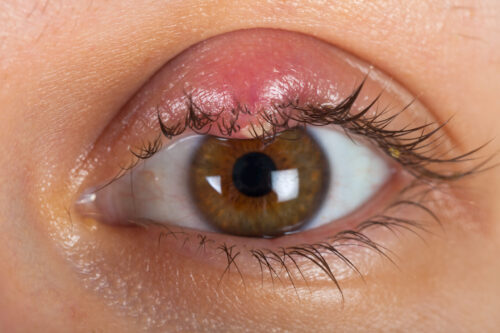Blepharitis
Discover comprehensive insights into what is blepharitis, its causes, symptoms, and effective treatments. Dive deep into the world of eye health with Théa. 

A stye, also known as a hordeolum, is an acute bacterial infection of the eyelid margin1 that affects the eyelash roots and/or the glands located into the eyelid edges1.
Styes are among the most common eyelid lesions in clinical practice. They are not serious but may be rather painful until they heal2,3.
Styes are frequently confused with chalazia, which is also a lump on the eyelid but do not result from an infection4. More information on chalazia can be found in this fact sheet.
A stye is caused by bacteria, mainly staphylococcal1, which are normally present on the skin and are responsible for most skin infections.

Styes are mostly external, involving the infection of an eyelash root and its associated oil glands (glands of Zeiss and Moll)1. Less frequently, styes may be internal, with the infected part being a Meibomian gland (another kind of oily gland)1.
Some risk factors favor the development of styes, such as1,5:
Some people are prone to repeated styes.
Styes are small abscesses: therefore, an external stye will present as a red lump at the base of an eyelash. A small pus spot can appear at the center of the bump4.
Internal styes are less obvious, and may appear as a mere red, swelling of the eyelid.
Stye is usually very painful, and in addition, there may be a feeling of something in the eye or itching or an oversensitivity to light4. Vision should not be affected3.
The eye may be watery or there may be crustiness along the eyelids edge4.
A stye usually only affects 1 eye, but it’s possible to have more than one at a time and on both eyes3.
At times, the abscess bursts and, in external styes, a small amount of pus is visibly released from the lump, while in internal styes, pus exude on the inner surface of the eyelid, and may be unnoticed6.
The diagnosis is based on history and clinical examination2, and no diagnostic tests are required or useful1.
A stye is usually a self-limiting condition with spontaneous resolution occurring within 1 or 2 weeks11,2.

Both internal and external styes are treated similarly1. Warming and gentle cleansing of the affected eyelid are the best treatment. Warmth helps the stye to come to a head, rupture and spontaneously drain7.
Painkillers help reduce the pain.
Antibiotics applied directly to the eye are sometimes prescribed to treat styes, but they usually provide little or no help, as most styes tend to resolve by themselves. Sometimes, oral antibiotics are given if the infection is spreading in the surrounding tissues7.
For an external stye, centered around a lash follicle, the lash can be pulled to enhance drainage2, but this must be done only by a health professional with appropriate antiseptic measures to avoid infection spreading3. If the stye is large or if it is refractory to medical therapy, incision and drainage under local anesthesia, performed by an ophthalmologist, may be considered2.
In general, don’t hesitate to ask your pharmacist for advice if you have any eye symptoms.
On the other hand, if you experience one or more of these symptoms, you should see an eye specialist as a matter of urgency; -Moderate,-Severe pain, -Intense sensitivity to light, -Decreased vision, -Flashes of light, -Dark spots, -Sensation of a foreign object in the eye, -Trauma (injury, contusion, acid burn etc.), -Persisting or worsening symptoms despite appropriate treatment.
